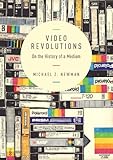Video Revolutions : On the History of a Medium.
Material type: TextPublisher: New York : Columbia University Press, 2014Copyright date: ©2014Description: 1 online resource (159 pages)Content type: text Media type: computer Carrier type: online resourceISBN: 9780231537759Subject(s): Video recordings - HistoryGenre/Form: Electronic books.Additional physical formats: Print version:: Video Revolutions : On the History of a MediumDDC classification: 302.234 LOC classification: PN1992.935 -- .N49 2014ebOnline resources: Click to View
TextPublisher: New York : Columbia University Press, 2014Copyright date: ©2014Description: 1 online resource (159 pages)Content type: text Media type: computer Carrier type: online resourceISBN: 9780231537759Subject(s): Video recordings - HistoryGenre/Form: Electronic books.Additional physical formats: Print version:: Video Revolutions : On the History of a MediumDDC classification: 302.234 LOC classification: PN1992.935 -- .N49 2014ebOnline resources: Click to View Intro -- Table of Contents -- Preface -- Acknowledgments -- 1. Three Phases -- 2. Video as Television -- 3. Video as Alternative -- 4. Video as the Moving Image -- 5. Medium and Cultural Status -- Notes -- Select Bibliography -- Index.
Since the days of early television, video has been an indispensable part of culture, society, and moving-image media industries. Over the decades, it has been an avant-garde artistic medium, a high-tech consumer gadget, a format for watching movies at home, a force for democracy, and the ultimate, ubiquitous means of documenting reality. In the twenty-first century, video is the name we give all kinds of moving images. We know it as an adaptable medium that bridges analog and digital, amateur and professional, broadcasting and recording, television and cinema, art and commercial culture, and old media and new digital networks. In this history, Michael Z. Newman casts video as a medium of shifting value and legitimacy in relation to other media and technologies, particularly film and television. Video has been imagined as more or less authentic or artistic than movies or television, as more or less democratic and participatory, as more or less capable of capturing the real. Techno-utopian rhetoric has repeatedly represented video as a revolutionary medium, promising to solve the problems of the past and the present—often the very problems associated with television and the society shaped by it—and to deliver a better future. Video has also been seen more negatively, particularly as a threat to movies and their culture. This study considers video as an object of these hopes and fears and builds an approach to thinking about the concept of the medium in terms of cultural status.
Description based on publisher supplied metadata and other sources.
Electronic reproduction. Ann Arbor, Michigan : ProQuest Ebook Central, 2018. Available via World Wide Web. Access may be limited to ProQuest Ebook Central affiliated libraries.

There are no comments on this title.